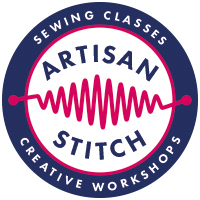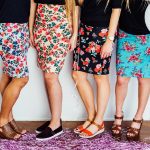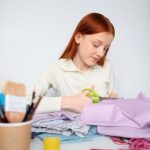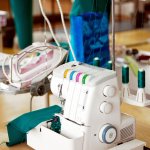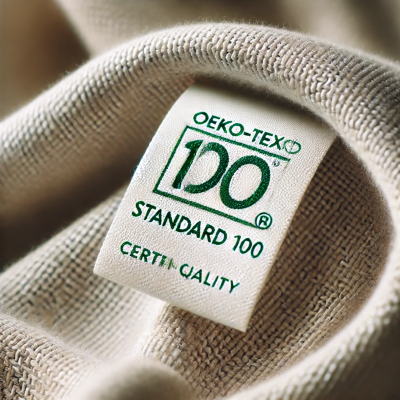
The OEKO-TEX® Rating System
If you’ve ever shopped for fabric or textile products, you may have come across the term OEKO-TEX® on labels or product descriptions. But what does it actually mean? And why should you care?
With growing concerns over harmful chemicals in textiles and the impact of fabric production on our health and the environment, certifications like OEKO-TEX® help consumers make more informed, responsible choices.
In this blog, I’ll explain the OEKO-TEX® rating system in simple terms, so you know what to look for when buying fabric—whether for dressmaking, home décor, or any other sewing projects.
What is OEKO-TEX®?
OEKO-TEX® is an independent certification system that tests textiles for harmful substances. It was developed by the International Association for Research and Testing in the Field of Textile and Leather Ecology, a globally recognized organization focused on textile safety and sustainability.
In simple terms, an OEKO-TEX® label means the fabric has been tested and is safe for human use—free from toxic chemicals at levels that could pose a risk. It also ensures responsible manufacturing practices, making it a trustworthy certification for health-conscious and eco-conscious buyers.
Why Does OEKO-TEX® Matter?
Textile manufacturing involves dyes, finishes, and chemical treatments that can leave behind residues. Some of these substances—such as formaldehyde, heavy metals, and pesticides—can be absorbed through the skin, inhaled, or even enter the body through prolonged contact.
Choosing OEKO-TEX®-certified fabrics provides reassurance that:
✔ They are free from harmful substances that could cause allergies or skin irritation.
✔ The production process follows strict safety standards, even if the fabric is made overseas.
✔ They are environmentally friendly, as OEKO-TEX® promotes responsible chemical use and water conservation. This makes OEKO-TEX®-certified fabrics an excellent choice for clothing, bedding, children’s products, and home textiles.
Different OEKO-TEX® Certifications and What They Mean
OEKO-TEX® has different certifications, each covering a specific aspect of textile safety and sustainability. Here’s a breakdown:
STANDARD 100 by OEKO-TEX®
- The most common certification for fabrics.
- Ensures that every component (threads, buttons, coatings) has been tested for harmful substances.
- Ideal for: Clothing, baby products, bedding, and any fabric that comes into direct contact with skin.
MADE IN GREEN by OEKO-TEX®
- Includes all the safety standards of STANDARD 100 but also guarantees sustainable and ethical production.
- Factories must meet environmental and social responsibility criteria.
- Ideal for: Consumers looking for both safety and sustainability.
LEATHER STANDARD by OEKO-TEX®
- Similar to STANDARD 100 but specifically for leather goods.
- Ensures that no toxic chemicals were used in the tanning or dyeing processes.
- Ideal for: Leather clothing, shoes, handbags, and accessories.
STeP by OEKO-TEX® (Sustainable Textile & Leather Production)
- A certification for manufacturers rather than individual products.
- Assesses environmental impact, chemical management, and worker safety.
- Ideal for: Factories that want to prove their commitment to responsible production.
How Does the OEKO-TEX® Rating System Compare to Other Certifications?
OEKO-TEX® isn’t the only textile certification out there. Here’s how it compares to others:
- GOTS (Global Organic Textile Standard) – Focuses on organic fibres and fair trade production, whereas OEKO-TEX® tests for chemical safety regardless of whether the fabric is organic.
- Bluesign® – Concentrates on environmentally friendly textile production by monitoring chemical use throughout the supply chain.
- B-Corp – A broader certification covering ethical business practices, whereas OEKO-TEX® is specific to textiles.
Key takeaway: If you want to ensure chemical safety, look for OEKO-TEX®. If you prefer organic materials, check for GOTS.
How Are Fabrics Tested for OEKO-TEX® Certification?
OEKO-TEX® tests fabrics for over 100 harmful substances. Some of the most important include:
- Heavy metals (lead, cadmium, mercury) – Can be toxic if absorbed through the skin.
- Formaldehyde – Often used in wrinkle-resistant fabrics but can cause skin irritation and respiratory issues.
- Pesticides and fungicides – Common in cotton production and linked to allergies.
- Azo dyes – Some can break down into carcinogenic substances.
Testing is done by independent laboratories, ensuring credibility and accuracy.
How to Identify and Buy OEKO-TEX® Certified Fabrics
1. Check the Label or Product Description
- Look for STANDARD 100 by OEKO-TEX® if you want a chemical-free fabric.
- Choose MADE IN GREEN for sustainable and ethical production.
2. Ask the Supplier
- Not all fabrics have visible labels, but a reputable shop should be able to confirm if their textiles are certified.
3. Verify the Certification Number
- Every OEKO-TEX® certificate has a unique test number that you can enter on the official OEKO-TEX® website to verify authenticity.
4. Be cautious of ‘greenwashing’
- Just because a fabric is advertised as “eco-friendly” doesn’t mean it’s safe or sustainable. Look for actual certifications rather than vague marketing terms.
Caring for OEKO-TEX® Certified Fabrics
Since these fabrics are tested for chemical-free properties, proper care will help maintain their quality:
- Use mild, eco-friendly detergents to avoid introducing unnecessary chemicals.
- Wash at lower temperatures to preserve both the fabric and the environment.
- Air dry when possible to reduce wear and energy consumption.
Final Thoughts
OEKO-TEX® is one of the most reliable textile certifications available today. It helps consumers make safer and more sustainable choices by ensuring that fabrics are free from harmful substances and, in some cases, ethically produced.
Next time you shop for fabric—whether online or in-store—keep an eye out for OEKO-TEX® labels. It’s a small step with a big impact for both your health and the planet!
Links: check out my blog on Fabric construction methods
OEKO-TEX® – Tailor-made solutions for the textile and leather industry
